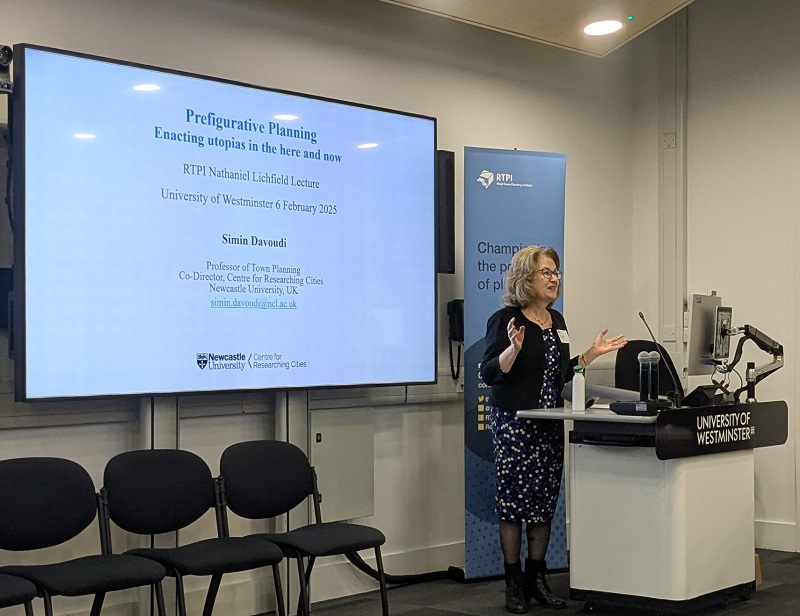Professor Simin Davoudi FRTPI FAcSS FRSA is a Professor of Town Planning at Newcastle University and also Co-Director of the University's Centre for Researching Cities initiative. Professor Davoudi delivered the 2025 RTPI Nathanial Lichfield lecture at the University of Westminster on 6 February and this blog summarises her lecture.
We are facing multiple interrelated crises of climate change, inequalities, divisions, declining public services, mistrust of democratic institutions, and a growing sense of the loss of the future especially among the younger generations. While responding to these challenges requires planning imagination and creativity, the opposite is happening. Decades of neo-liberalising reforms of planning, debilitating cuts to its resources, and demoralising assaults on its efficacy and legitimacy have stripped planning from its creative potentials and reduced it to a series of ‘tick-boxing’ procedures.
As David Harvey once put it, a ‘sclerosis of imagination’ has taken hold and ‘no-one believes any more that we can build that city on a hill’. This creeping pessimism and the absence of hope for the future have led to a reluctance to imagine places that do not yet exist. It seems that planning has become more at ease with accommodating the normalised today than pursuing desired futures. Utopian thinking seems to have been assigned to the dustbin of planning ideas. But, without it planning risks becoming a technocratic exercise.
That is why I used the opportunity of presenting this year’s RTPI Nathaniel Lichfield lecture to call for a return to utopianism as a vital force in planning and its progressive intents. As a key function of hope, utopian thinking helps us to see the existing conditions not as how things are, but as how they are made to be, and how they might be remade. This combination of criticality and creativity is the essence of prefigurative planning which entails a critical process of negating the given realities, and a normative process of envisioning alternatives and enacting utopic futures in the here and now. Instead of waiting for a wholesale structural and institutional change, prefiguration seeks to build the new in the shell of the old but without limiting it to the boundaries of the old.

Professor Davoudi delivered the 2025 RTPI Nathanial Lichfield lecture at the University of Westminster
In our field, negating the given means questioning fabricated ‘realities’ which tell us that cities should function like ‘growth machines’ by rolling-out financialised real estate developments and even becoming safe-deposit-boxes for anonymous, illicit money. That public interest is best served not by caring for people, places and planet, but by boosting profit-driven speculative developments.
Critiquing the undesirable status quo is a key feature of prefigurative planning but equally important is the envisioning of alternatives and the enacting of utopias in the present. The uncovering of the not-yet-possibilities generates radical and transformative hope and makes utopianism a constituent part of being human.
Unlike the idealised, end-state utopia of modernist planning, the utopias of prefigurative planning unfolds through experimenting with alternative ways of spatial interventions within the conditions of the present but without being limited to them. The emphasis is on the process rather than a single pre-conceived outcome; it is on the journey rather than the destination.
As a collective process, prefigurative planning may involve conflicts, but instead of seeking to foreclose the debate, disagreements are seen as opportunities for learning. Its outcomes and processes are inevitably contingent, uncertain and potentially disappointing, but they are never hope-less, because radical hope is inherently open-ended and, hence, cannot be defeated.
There are numerous examples of community-led planning initiatives in the UK and beyond, which although may not be called prefigurative planning, they share a common feature with it and that is the disruption of the taken-for-granted ways of doing things and the enactment of imaginative alternatives. We need to take inspirations from these civic energies and creative impulses that demonstrate how things can be done differently.
There are also numerous examples of prefigurative actions by planners in the UK and around the world who, despite challenging environments, have carefully navigated power relations to breakup, work through or bypass institutional limitations in order to enact change in the here and now. And, in doing so, they have not only mobilised hope, but also created a sense of personal agency and collective efficacy.
Prefigurative planning is a call for returning to a utopianism that does not settle on utopias, but rather embarks on a process of endless questioning and enacting alternatives in the here and now. Utopianism in this sense is not about how to build ‘that city on a hill’ but how not to give up the pursuit of ‘better’ cities with planning imagination.
Acknowledgment
The lecture and the Blog are based on the following open access paper which also includes the sources used: Davoudi, S. (2023) Prefigurative planning, performing concrete utopias in the here and now, European Planning Studies 13(11): 2277-2290.


